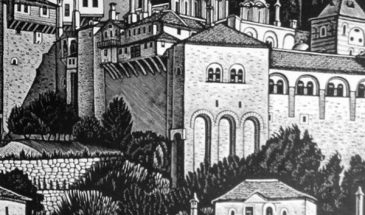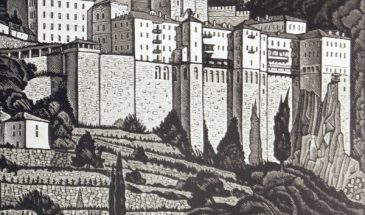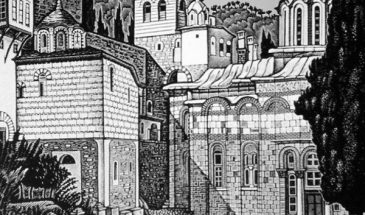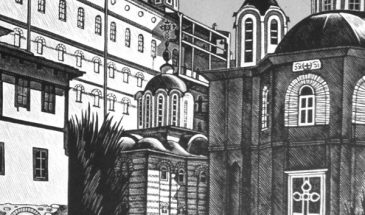- Overview
- Itinerary
- Included
- Not Included
- Gallery
- Booking
Two-Day Mount-Athos A’
Mountain Athos is the top site to experience simultaneously the imprint of historical time together with its absolute absence. Throughout the course of history, the achievements of Greek civilization are preserved not only to maintain the knowledge of the past, nor just for esthetic reasons — they are also practiced in the daily routines of the monks, thus creating a bridge between history and the modern world.
The road trip is accompanied by a guide specialized on religious tourism.
Two-Day Mount-Athos A’
1st day
Ouranoupoli – Monastery of Xenophon – Monastery of St. Panteleimon – Karyes – Koutloumousiou Monastery – Stavronikita Monastery – Iveron Monastery
2nd day
Skete of Prophet Elijah – Monastery of Pantokrator – Vatopedi Monastery – Dokheiariou Monastery – Ouranoupoli
Itineraries
Ouranoupoli
1st day-Morning
You will first stop at the pilgrim’s office to get the entry permit for Mt. Athos.Monastery of Xenophon
1st stop
From Ouranoupoli you will set sail for the Monastery of Xenophon. The monastery was established by Hosios Xenophon in the late 10th century to honor St. George the Megalomartyr (the Great Martyr).Among the relics, there are parts of the skulls of St. Stephan, St. Panteleimon and St. Tryphon. Also, you'll see one mosaic icon of St. George and one St. Dimitrios as well as the wonder working icons of Panagia Odigetria and St. George the Megalomartyr.Monastery of St. Panteleimon
2nd stop
The Monastery of St. Panteleimon will be your next stop. It was built on the shore of a small bay and it was dedicated to the Saint-healer, Panteleimon. Since 1835 it has been inhabited by Russian monks. The Holy Monastery is home to a rich collection of heirlooms such as donations offered by various Tsars, holy vestments, a part of the Holy Cross and icons among which are the wonderworking icon of Panagia Odigetria (Our Lady the Guide) and the wonderworking icon of St. Panteleimon. According to tradition, the latter originates from the small monastic settlement of Xylourgos that was founded in 1030.Karyes
3rd stop
Continue with a visit to Karyes, the famous capital of the Monastic State of Mt. Athos, where the administrative head is based. The Administration consists of two bodies: the Holy Community and the Hiera Epistasia. Here, you may pay homage to one of the most revered icon of Our Lady, Axion Estin, located in Protaton, the central church of the peninsula. Tradition has it that before the specific icon an angel first chanted the renowned hymn of ‘Axion Estin.’ The Church of Protaton is one of the oldest ones in Mt. Athos. It was founded by St. Athanasios the Athonite during the first half of the tenth century and it was then renovated by Andronicus II Paleologos (1282-1328). Protaton is dedicated to the Dormition of Virgin Mary. The chapel of St. John Prodromos is also located in the same area.Koutloumousiou Monastery
4th stop
After Karyes, you’ll visit Koutloumousiou Monastery. The wonderworking icon of Panagia Fovera Prostasias (Our Lady the Great Protector) is kept in the katholicon of the church. The monastery also houses a piece of the Holy Cross and parts of the holy relics of Saint Anne and St. Gregory the Theologian.Stavronikita Monastery
5th stop - Noon
The little Monastery of Stavronikita follows next. It is built on a rock nearby the sea. The most important heirloom you’ll see is the mosaic icon of St. Nikolaos Stridas that appears to have been found in the late 13th to the early 14th century. Tradition has it that in 1545 the icon was pulled out of the sea by fishermen. On the forehead of the saint’s portrait was a three-inch-long cut with a big oyster attached to it. When the fishermen pulled the shell away, something shocking happened! Blood started to pour out of the cut. Thus, the icon was named St. Nikolaos the Stridas, meaning St. Nicholas-of-the-Oyster. Also, the monastery houses heirlooms, such as pieces of the Holy Cross, and relics, such as those of St. John Chrysostom and the Forty Martyrs of Sebastia.Iveron Monastery
6th stop
You will then visit the Monastery of Iveron, located on the north-east side of Mt. Athos. Here, you may pay homage to the wonderworking icon of Panagia the Portaitissa (All-holy Virgin of the Gate), one of the most famous and revered icons of the area. The icon was miraculously delivered to the monastery via sea in the early 11th century. Tradition has it that the icon used to belong to a devout widow that lived in Nice. When the iconoclasts arrived at her door and demanded that she handed it to them, the widow managed to convince them to let her keep it for another day. Meanwhile, she threw the icon in the sea. To her surprise, though, the icon rose from the water and begun to pull away until it completely vanished into the horizon. One night, many years later, the monks of Mt. Athos all of a sudden saw a beam of light. They could just barely make out that it was an icon of the Virgin approaching the shore. The Mother of God herself chose the monk worthy of pulling the icon on shore. In a rejoicing atmosphere, the icon was transferred to Iveron Monastery where it is housed until today. In the sacristy of the monastery, you may also see holy relics, gold-work embroidery vestments, the bag of the Emperor Ioannis Tsimiskis, the mantle of St. Gregory V and the will that he left. Also, a piece of the Holy Cross is kept here together with the many relics and various heirlooms that date back to the merciless Passions of Christ. Such heirlooms are pieces of the sponge, the reed, the cloak and the column, against which He was whipped. In Iveron Monastery you will attend the Evening Prayer and dine in the Refectory together with the monks and the other pilgrims. You’ll also spend the night there and experience the monastic way of life to the fullest.Skete of Prophet Elijah
2nd day - 1st stop
You will leave Iveron Monastery behind and head to the Skete of Prophet Elijah. The skete is organized as a commune and it is in the diocese of the Monastery of Pantokrator. The skete was established in 1757 by St. Paisios of Velitskovsky. The same saint also disseminated the nyptic theology and the tradition of mental prayer to the Slavic countries. Two large icons of Virgin Mary are kept in the skete: one of Panagia Galactotrofousa (the All-holy Virgin the Milk-giver) and the other of Tikhvin Dakriroousa (from the Russian village of Tikhvin). The skete houses the relics of several saints such as the left heel of St. Andrew Protoklitos (the First-called) as well as holy items such as pieces of the robes that Jesus and Mary used to wear.Monastery of Pantokrator
2nd stop
Next stop is the Monastery of Pantokrator. The monastery resembles a medieval castle. The two brothers, Alexios the Stratopedarch and Ioannis the Primikerios, who are buried in the narthex of the katholicon, founded the monastery in the 14th century. The katholicon is dedicated to the Transfiguration of Christ. Many cells and chapels are in the diocese of the monastery. The cell of Axion Estin is the most important of all since it has been named after the wonderworking icon of Virgin Mary that was housed there. Nowadays, the icon is hosted in the Church of Protaton, in Karyes. The icon of Panagia Gerontissa, which was given as a gift by the Byzantine Emperor Alexios I Komnenus, is now the monastery’s main icon. Many holy heirlooms and holy relics can also be seen there, such as a part of the Holy Cross and the relics of Apostle Andrew the Protokletos (the First-called), St. John Chrysostom, St. Athanasios and those of other saints as well.Vatopedi Monastery
3rd stop
A tour in the Vatopedi Monastery follows. It is the second largest complex of buildings in Mt. Athos after the one of Great Lavra. Vatopedi Monastery is home to many icons depicting Virgin Mary such as Panagia Pantanassa, Panagia Esfalmeni, Panagia Antifonitria, Panagia Paramythia, Panagia Ktitorissa, Panagia Vimatarissa, Panagia Pyrovlithissa, Panagia Eleousa, and Panagia Eleovrytissa. The sanctuary of the monastery houses the holy relics of several saints such as the holy skull and the intact ear of St. John Chrysostom, one of the most important teachers and illuminators of Christianity who was also the Archbishop of Constantinople. The holy skull of St. Gregory the Theologian is displayed as well, together with various holy heirlooms such as the three parts of Virgin Mary’s Holy Girdle. Other imperial and royal offerings kept in the sacristy are also worth seeing.Dokheiariou Monastery
4th stop - Noon
Once your tour in Vatopedi Monastery has been completed, you’ll be transferred to Dokheiariou Monastery. The monastery was established by the monk Efthemios who was the disciple of St. Athanasios, the storekeeper (Greek: ‘dokheiarios) of the Monastery of Great Lavra. The katholicon is dedicated to the two Archangels, Michael and Gabriel. Also, the monastery is home to the wonderworking icon of Panagia Gorgoipikoou, the holy relics of St. Charalampos, St. Minas and St. Kirikos as well as parts of the relics of St. Theodoros Stratelates and St. Kosmas the Anargyros (the Unmercenary Healer).Ouranoupoli
5th stop - Afternoon/Return
At this point your tour in Mt. Athos has come to an end. From the small dock of Dokheiariou Monastery, you'll embark towards Ouranoupoli.- Transfers in Mt. Athos according to the schedule
- Marine transfer from/to Ouranoupoli
- Tour guide services
- Entry permit arrangements
A charge is needed for the entry permit to Mt. Athos.
- Eastern Orthodox Christians: 25,00€.
- Non- Orthodox Christians: 30,00€.
- Children: 10,00€.
Extra services:
- Pick-up and drop-off from/to your hotel or elsewhere










